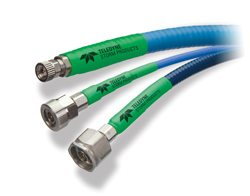 One thing that the test and measurement, sensors, radar and wireless markets all have in common is the need for robust, high performance microwave cable assemblies. A major attribute of such cables is electrical stability, which has been achieved through the development and advancement of cable technology over many years of manufacturing and applications experience.
One thing that the test and measurement, sensors, radar and wireless markets all have in common is the need for robust, high performance microwave cable assemblies. A major attribute of such cables is electrical stability, which has been achieved through the development and advancement of cable technology over many years of manufacturing and applications experience.
The ability of a cable to deliver a signal in good condition with the minimum of loss and delay is the essence of microwave cable design. This is a specific attribute of the new Teledyne Storm 190E Phase Master microwave cable, which is an enhanced version of the 190 Phase Master that has been a standard in the engineers' tool kit for many years. The 190E provides enhanced performance in a number of areas that are becoming increasingly important as signal frequencies increase and the performance requirements, both mechanical and electrical, are becoming more demanding.
In particular it addresses the need for a high level of phase stability versus temperature and cable flexure, reduced insertion loss, increased amplitude stability, improved shielding effectiveness, greater connector retention, and additional mechanical durability focusing on torsion resistance. The result is an amalgamation of Teledyne Reynolds' cable design technology and experience, taking into account customer demands, to bring higher performance cables to the market. The 190E is specified up to 26.5 GHz, dependant on the connector used, the industry standard SMA connector is specified to 18 GHz and the 3.5 mm connector is specified up to 26.5 GHz.

Figure 1 Construction of the 190E Phase Master microwave cable.
Cable Construction
The cable construction (shown in Figure 1) is a proprietary combination of a silver plated copper (OFHC) centre conductor [A], a MicroForm™ PTFE tape wrapped dielectric [B], four screening layers, alternate helically wrapped silver plated copper foil [C and E] and silver plated copper braid [D and F], with a blue FEP unarmored jacket (5.05 mm diameter) [G] as standard.
Additional armored jackets to enhance the robustness of the cable include:
Ruggedized - Polyurethane Jacket (see Figure 2), which is for applications where weight, flexibility and abrasion resistance are critical, and moderate compression resistance is required (300 lbs/in). The cable is covered with a flexible wound helix of passivated stainless steel wire and an extruded polyurethane jacket. Its temperature range is -54° to +100°C.

Figure 2 Cable with ruggedized, polyurethane jacket.

Figure 3 Hard armored cable.
Hard Armored (see Figure 3) is suitable for both inside and outside environments where the application requires the ultimate in cut and crush resistance (500 lbs/in), and flexibility and weight are not as critical. The cable is covered with stainless steel interlocked armor and its temperature range is -54° to +135°C.
The complete cable specifications for the 190E Phase Master Cable are shown in Table 1. The exceptional shielding effectiveness, high levels of phase stability with temperature and flexure, and the much improved cable retention capabilities are all products of engineering development driven by market demands.

The shielding effectiveness is a capability that enables cables to be located in close proximity to other cables and equipment. Figure 4 shows the shielding effectiveness by comparison with a competitor's cable in both new and used conditions. Although there is some reduction in shielding effectiveness with use, the 190E shield construction effectively minimizes that reduction. The effect is a more stable, longer lived cable.

Figure 4 Graph of shielding effectiveness.

Figure 5 Phase Master 190E phase vs. temperature.
Phase stability performance is affected by both temperature and flexure during use. The 190E is designed to minimize phase shift for both temperature and flexure. Figure 5 demonstrates the minimal effects of both those environmental conditions. The temperature range is -55° to +125°C with a <800 ppm phase shift at the maximum temperature. Figure 6 demonstrates the phase shift due to flexure. The phase shift with the cable in a 90° bend around a 4.0 in (100 mm) mandrel is nominally 1° at 18 GHz.

Figure 6 Phase Master 190E phase vs. flexure.
Conclusion
The 190E Phase Master microwave cable is aimed at test and measurement, radar, wireless communications, electronic warfare and antenna systems applications. The overall cable stability and specifically the phase stability, leakage shielding and rugged construction are ideally suited to applications in semiconductor test and measurement where repeated use of the test equipment and the high throughput of the device under test require the performance repeatability and environmental ruggedness to work and survive over long periods of use.
For applications in military markets, the ruggedness of the cable is as important as the repeatability of the electrical specification of the cable. For all RF applications the need for insertion loss repeatability and VSWR stability are a given, but the addition of phase stability, especially where the cable is used in harsh environments, becomes a matter of paramount importance. The combination of the design features and the interlocking electrical and environmental performance capabilities delivered by the design provide the robust, high performance cables required to meet today's customer demands.
Teledyne Reynolds,
Newbury, UK
Tel: +44 (0)1635 262200,
www.teledyne-europe.com.
RS No. 300
